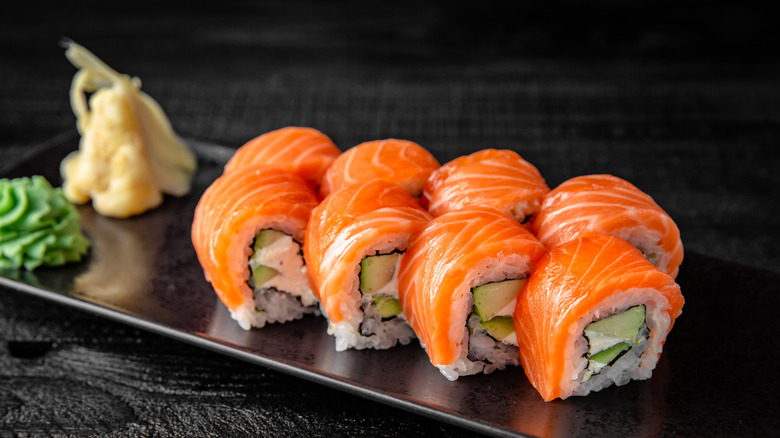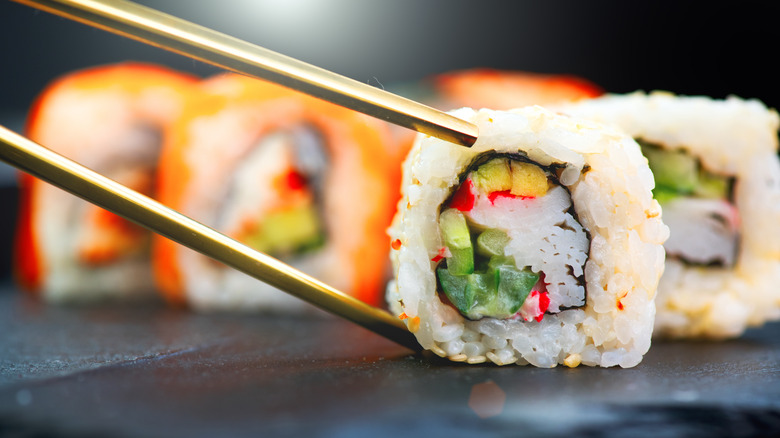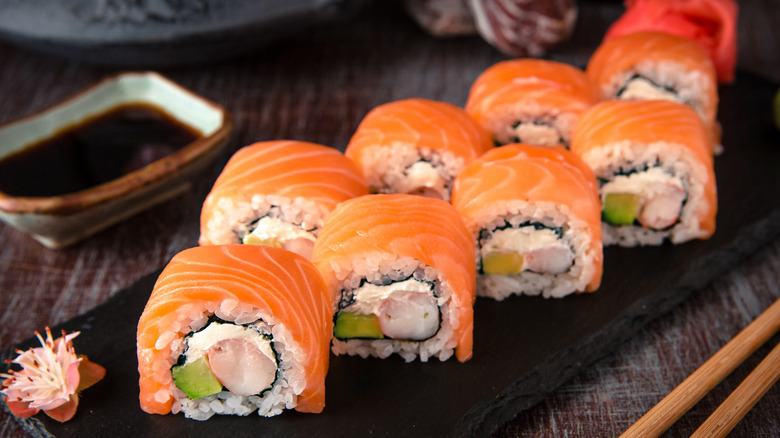Philadelphia Roll: What You Should Know Before Ordering
The Philadelphia roll is sort of like the California roll, in that people may mistakenly associate the roll with the place. Though in this case, the roll was both named and not named after Philadelphia, depending on which story you believe.
Despite its name, the California roll actually originated in Canada. Similarly, people may recognize that the Philadelphia roll is named after the cream cheese, and think the cream cheese comes from the city. As The Philadelphia Inquirer explains, though, Philadelphia Cream Cheese was invented by the Kraft Heinz Co. in New York in 1872. It was named after Philadelphia to brand it with the dairy farmlands for which it was once famous.
But even though the cream cheese isn't from Philly, the Philadelphia roll itself is. According to Shogun Japanese Steakhouse, Madame Saito, the city's "Queen of Sushi," arrived in Philadelphia after having moved from Japan to Paris. In the 80s, she opened a sushi restaurant in Reading Terminal, the city's central food destination, and the mayor commissioned a sushi for the city. So, taking inspiration from the amount of Jewish customers she served, she created the Philadelphia roll to approximate a lox sandwich. Later, she would explain to The Philadelphia Inquirer that it was supposed to be the "Jewish roll," but her customers repeatedly insisted that it was the Philly roll.
Of course, no actual records of this exist. Another equally unsubstantiated claim states it emerged from San Diego, California in 1985, receiving its name from the cream cheese that defines its recipe (via YouMe Sushi).
What goes into the Philadelphia Roll
The website Next Shark would not call the Philadelphia Roll sushi, though. The issue is that the Philadelphia Roll expands beyond the rice, rice vinegar, seaweed, and fresh raw fish or vegetables that form the basis of traditional sushi. However, in terms of the food fusion that defines the staples of American sushi, the Philadelphia roll has its own appeal.
The ingredients for a Philadelphia roll, as Tasty describes, consist of sushi rice, rice vinegar, smoked salmon, cream cheese, and cucumbers. All About Sushi expands on this, adding onions and insisting that if you are going to make this roll, you should really use Philadelphia Cream Cheese and not a cheaper brand. Other sites, like H-E-B, note that the roll can contain imitation crab instead of smoked salmon. The Health Bazaar adds that you could also include avocados, scallions, and sesame seeds.
So, the barest consensus of what makes a Philadelphia roll a Philadelphia roll is the use of cream cheese, especially Philadelphia Cream Cheese, with fish. Everything else, including whether the salmon serves as a filling or as a wrapping like in the picture above, seems tangential.
Making a Philadelphia Roll
In 2020, Madame Saito, the self-professed creator of the Philadelphia roll, shared her recipe with 6ABC. Cut some nori on a bamboo mat, and cover it with seasoned sushi rice. Flip it. Cover the other side with Philadelphia Cream Cheese and smoked salmon. Roll so that the rice is on the outside. Coat with sesame seeds and serve the original Philadelphia roll.
The Tiger Corporation, a Japanese manufacturer of rice cookers, has their own broadly similar recipe but also offers tips for people less certain in the ways of making sushi in general than Philadelphia Rolls in particular. Mix the cooked rice with rice vinegar, sugar, and salt. Wrap with plastic the bamboo map with which you intend to roll the sushi and prepare a bowl of water. Lay your seaweed shiny side down upon the mat, plop rice, and wet fingers in preparation of rice spreading. After you spread it evenly and sprinkle some sesame seeds, turn the whole sheet over so that it, like in Madame Saito's recipe, has the rice facing down. Add your other ingredients, roll the sushi, and cut the resulting log into pieces for consumption. Voila! You have prepared a staple of American-Japanese fusion.


